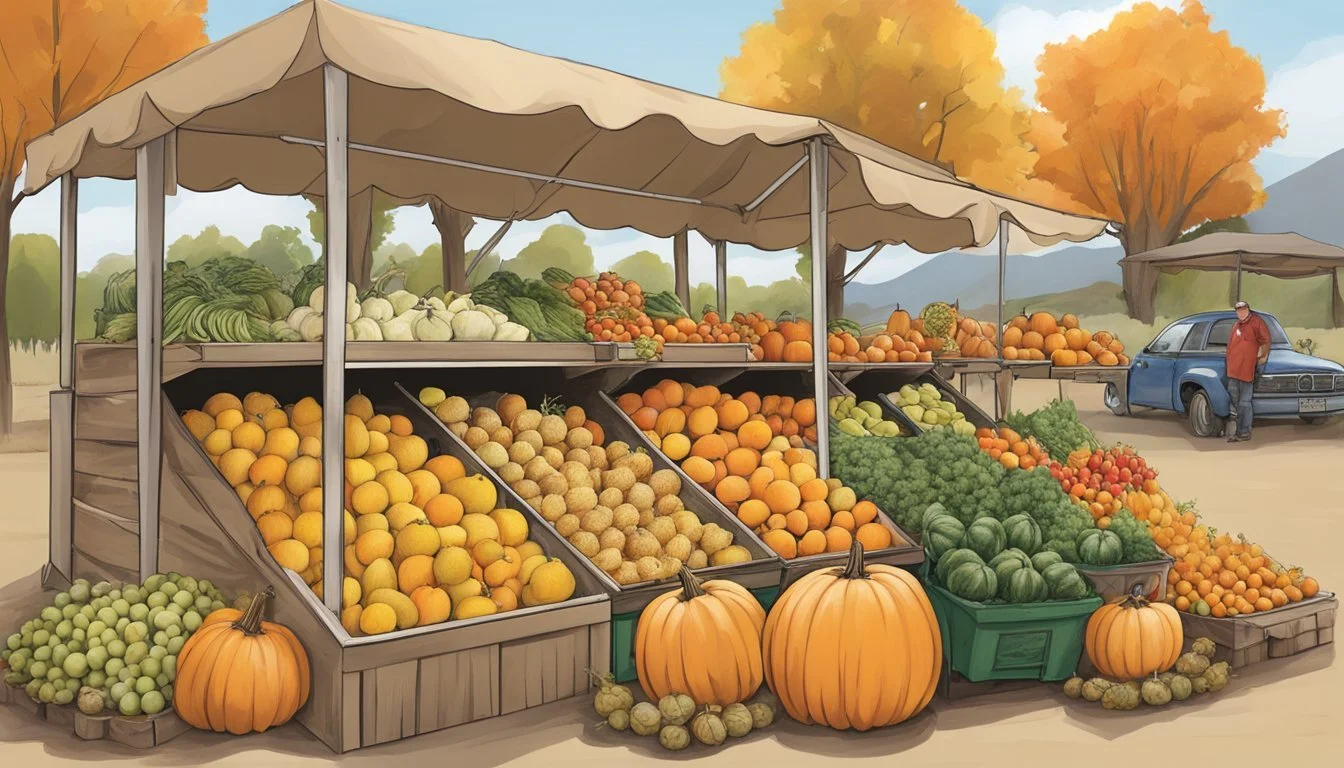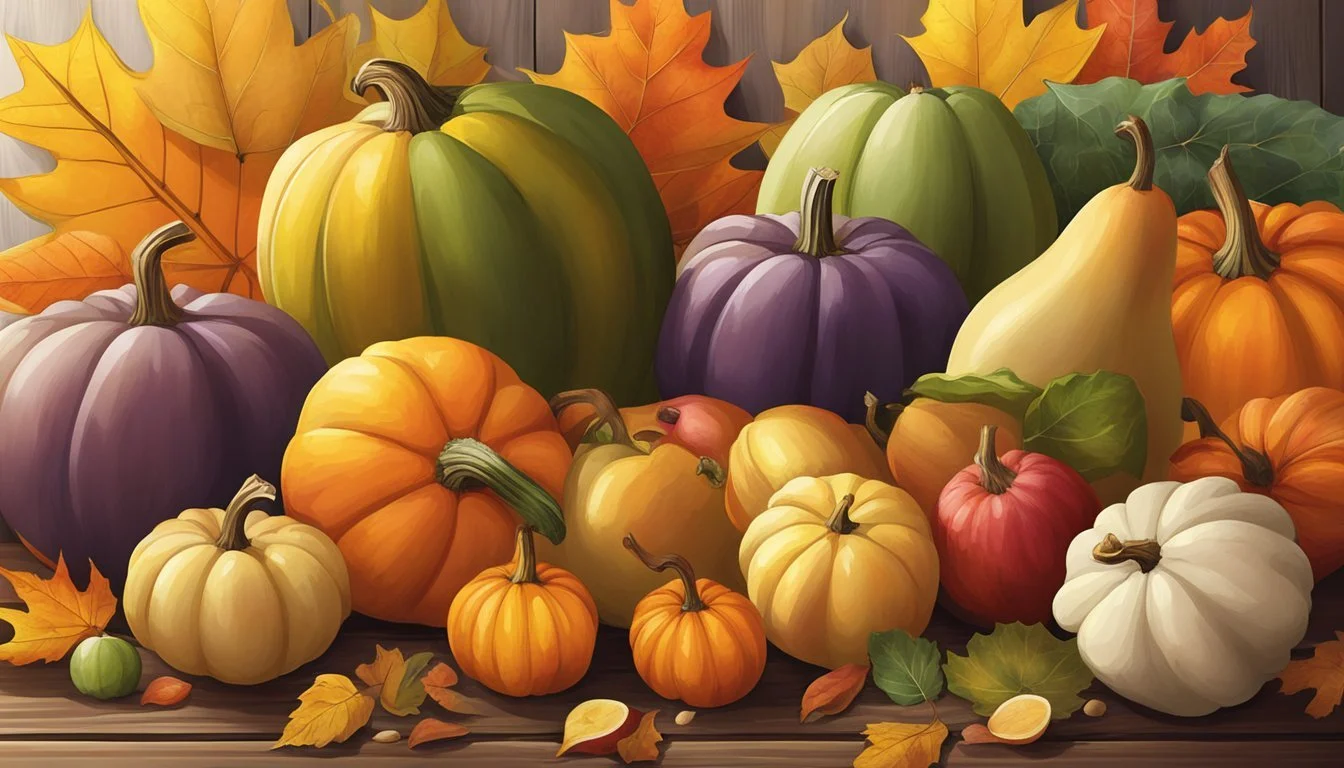Idaho Seasonal Fruit & Vegetables in October
Your Guide to Fresh Picks
This Article is Part of our Idaho Seasonal Fruit & Veg Calendar
In October, Idaho's diverse climate yields a bountiful harvest of fruits and vegetables, making it an excellent time for locals and visitors alike to experience the region's agricultural wealth. This mid-autumn month offers a variety of seasonal produce that ranges from the last of the summer's berries to the first of the winter squash. The harvest includes crops that thrive in the cooling temperatures, such as pumpkins and root vegetables, which are staples in the preparation of hearty, warming dishes.
The state's farmers are busy during this period, collecting the ripe produce at the peak of its freshness. Idaho's October harvest is characterized by rich, flavorful produce that includes blackberries, known for becoming sweeter and less tart as the season progresses. Additionally, a variety of squashes, potatoes, and pumpkins come into season, offering ample opportunities for savory meals and festive decorations alike.
Consumers can indulge in these seasonal offerings by visiting local farmers' markets or participating in the pick-your-own experiences offered by some farms. Making the most of the seasonal calendar not only ensures the freshest, tastiest produce but also supports the local economy and promotes sustainable eating habits by reducing the demand for out-of-season, transported goods.
Seasonality of Produce in Idaho
In Idaho, October marks a distinctive transition in the availability of fresh produce, which shifts according to the fall season's harvest schedule.
Understanding Seasonal Eating
Eating seasonally refers to the practice of consuming fruits and vegetables around the time they are harvested in their natural growing cycle. For Idaho residents, October presents a variety of fresh, seasonal produce. Potatoes and apples (how long do apples last?) are the flagbearers of Idaho's fall harvest, but they are accompanied by an assortment of other fruits and vegetables that reach optimal ripeness during this month. The table below outlines typical produce one may find in Idaho during the fall season:
In Season October Apples Pears Potatoes Pumpkins Winter Squash Sweet Potatoes Turnips Rutabagas
Benefits of Seasonal Produce
Consuming produce during its peak season has multiple benefits. Freshness is one; when fruits and vegetables are eaten soon after harvest, they retain more nutrients and flavor. In October, Idaho's seasonal produce also tends to be more cost-effective, as the abundance from local harvests reduces transportation and storage costs. Supporting local farms by purchasing seasonal items promotes sustainability and strengthens the local economy. Moreover, seasonal eating introduces variety into one's diet, aligning with the natural diversity of the year's changing cycles.
Prime Vegetables in October
In October, Idaho’s fields yield a bountiful harvest of vegetables, presenting a perfect opportunity for seeking out the freshest root vegetables, leafy greens, and a variety of squash and pumpkins ideal for autumnal dishes.
Root Vegetables Availability
Beets (how long do beets last?): Prized for their sweet, earthy flavor, beets are abundant in October. They can be enjoyed roasted or incorporated into salads. Parsnips: Another root vegetable reaching its peak, parsnips lend a sweet, nutty taste to stews or can simply be sautéed.
Potatoes: Idaho’s iconic vegetable is widely available and perfect for baking, mashing, or frying.
Carrots and Garlic: These staples are also plentiful, adding depth to soups and roasted vegetable medleys.
Leafy Greens Selection
Kale and Cabbage: These greens thrive in cooler temperatures, becoming sweeter after a frost. They are excellent in salads, steamed, or sautéed. Broccoli and Brussels Sprouts: Rich in nutrients, both are ideal for roasting or as an addition to hearty autumn salads.
Spinach: This versatile green is tender and flavorful, right for salads or a sautéed side dish.
Swiss Chard: With bright, colorful stems, Swiss Chard stands out both in the garden and on the plate.
Options for Squash and Pumpkins
Pumpkins: Beyond jack-o'-lanterns, pumpkins offer savory options for pies and soups. Butternut Squash: (how long does butternut squash last?) With a creamy texture, it is well-suited for soups and as a sweet roasted side.
Winter Squash: Varieties like acorn and spaghetti squash are ripe and ready for baking and stuffing.
Corn: While not a squash, corn remains an October staple, whether grilled, boiled, or enjoyed off the cob.
With an array of cooking methods like roasting, steaming, and sautéing, these vegetables from Idaho are essential components for countless autumn recipes.
October Fruits to Enjoy
October marks the season when Idaho's orchards yield a bounty of fruits, and specialized crops offer unique flavors. This diverse range provides for a range of culinary uses.
Tree Fruits Selection
Apples: Idaho boasts a variety of apples reaching their peak in October. Among them are:
Crispin: Known for their sweet flavor, ideal for both eating raw and baking.
Fuji: Offers a crisp texture with a sugary taste, perfect for snacking.
Granny Smith: A tart option loved for pies and crisps.
Pears: Pears come into their own during October, with several varieties available:
Bartlett: These transition from a signature summer fruit into autumn with rich, sweet flavors.
Bosc: With a firmer texture, these pears are excellent for poaching.
Persimmons: Offering a honey-like taste, they're often used in desserts, or eaten fresh.
Berries and Uncommon Picks
Grapes: Vineyards in Idaho produce grapes that are juicy and full-flavored in October. Varietals include:
Concord: Known for their bold taste and suitability for jellies and juices.
Thompson Seedless: A versatile grape ideal for fresh eating or raisin production.
Other Fruits:
Figs: Idaho's figs have a short season and are typically rich in flavor, enjoyed fresh or dried.
Quince: A less common fruit with a tart flavor, requiring cooking to bring out its sweetness, often turned into jellies or desserts.
Recipe Ideas Featuring October Produce
In Idaho, the autumn season brings a bounty of fresh produce that can be transformed into both savory and sweet culinary delights. Chefs and home cooks alike have the opportunity to enhance their dishes with the flavors of fall, utilizing everything from crisp apples to earthy squash.
Savory Dishes with Seasonal Vegetables
Butternut and Spaghetti Squash Risotto: A creamy dish that highlights the sweetness of butternut squash paired with the al dente texture of spaghetti squash. It's flavored with sage leaves and can be enriched with a dollop of ginger-infused sauce for added depth.
Ingredients: Arborio rice, roasted butternut squash, roasted spaghetti squash, fresh sage, chicken or vegetable stock, onion, garlic, ginger, butter, and Parmesan cheese.
Method: Sauté onions and garlic, add rice, then gradually incorporate stock, roasted squashes, and sage. Finish with butter and Parmesan.
Roasted Vegetable Salad with Spinach and Cucumber: This healthy salad is an excellent source of fiber. It combines roasted seasonal vegetables with the freshness of cucumber and the nutritional benefits of spinach leaves.
Ingredients: Mixed autumn vegetables (including squash), cucumber, fresh spinach, olive oil, balsamic vinegar, salt, and pepper.
Method: Toss vegetables in olive oil and roast. Mix with sliced cucumber and spinach leaves. Drizzle with balsamic vinegar before serving.
Sweet Treats from October Fruits
Apple Cobbler with Ginger Crumble: A traditional dessert that showcases the freshest apples of the season. The ginger crumble topping brings a warming spice that complements the soft, sweet apples beneath.
Ingredients: Apples, flour, ginger, sugar, butter, cinnamon, lemon juice, and baking powder.
Method: Slice apples and layer them with lemon juice and cinnamon. Mix crumble topping with flour, sugar, ginger, and butter, then sprinkle over the apples and bake.
Pear and Apple Tart: The combination of pears and apples in this tart creates a delightful contrast in both flavor and texture. The addition of a flaky pastry crust makes it a crowd-pleaser.
Ingredients: Pears, apples, pastry dough, sugar, cinnamon, nutmeg (how long does nutmeg last?), and butter.
Method: Slice pears and apples and arrange on rolled-out pastry dough, sprinkle with sugar mixture, dot with butter, and bake until golden.
Storage and Preservation
October in Idaho presents a bounty of seasonal fruits and vegetables. Storing and preserving these locally-grown products correctly ensures their freshness and flavor for as long as possible, reducing waste and maximizing value.
Best Practices for Fresh Produce
When dealing with fresh produce such as October-harvested celery (how long does celery last?) and various salads, it is paramount to understand that correct handling and storage can significantly affect their shelf life and taste. For celery, storing it in the refrigerator in a sealed container or wrap can help maintain its crispness and moisture. Salads, being more delicate, are best kept in the crisper drawer of the refrigerator, in containers lined with paper towels to absorb excess moisture.
Fridge Storage Tips for Celery and Salads:
Celery: Seal in a container or wrap tightly with aluminum foil.
Salads: Store in the crisper, in containers with paper towels.
Techniques for Extending Shelf Life
To preserve the quality of Idaho's fruits and vegetables, one may employ a variety of preservation techniques. Drying, freezing, and canning are all effective methods, each suitable for different types of produce. For items typically included in salads, which are consumed fresh, it is best to use them promptly. However, other vegetables can be blanched and frozen, ensuring the retention of nutrients and flavor. Blanched vegetables can be used later in cooked dishes or thawed for inclusion in salads.
Preservation Techniques:
Drying: Ideal for herbs and some fruits.
Freezing: Suitable for blanched vegetables.
Canning: Good for fruits and vegetables to be stored long-term.
When preserving, always ensure that produce is fresh and fully cleaned before processing. This will help maintain the quality and safety of the produce for future use.
Seasonal Eating Beyond October
As the calendar pages flip beyond October, seasonal eating in Idaho transitions from the harvests of fall to the storage-friendly produce of winter. Consumers can continue to relish fresh flavors by understanding the shifting availability at local markets during these cooler months.
Transitioning Produce of November and December
In November and December, Idaho's produce selection adapts to resilient vegetables and storage crops. Root vegetables take center stage, providing substantial nutrients and flavors well-suited to hearty winter dishes. Markets often feature:
Potatoes: A staple that moves from the fields into ample storage, ensuring a consistent supply.
Sweet potatoes and yams: Their natural sweetness intensifies with storage, making them a versatile ingredient.
Winter squash: Varieties like butternut and acorn squash remain readily available.
Beets: The enduring beet, with both root and greens, provides earthy flavors (What wine goes well with earthy flavors?) and robust nutrition.
Carrots: These remain sweet and crisp, a favorite for winter snacking and stews.
These vegetables, along with apples and pears in storage, help to extend the local eating season. It's crucial to support local farmers through these transition months, allowing communities to benefit from the nutritional and economic advantages of eating seasonally.
Early Harvests to Anticipate
Once the winter season settles in, it's a waiting game until the first fresh produce of spring appears. Early harvests typically begin in April, with the following being some of the first signs of the season:
Greens: Spinach and Swiss chard can often be planted and harvested early.
Herbs: Hardy varieties like parsley and cilantro are quick to sprout in the cool soil.
Beyond the early greens, consumers eagerly anticipate the summer months, starting in June and July, when Idaho's markets will burst with variety, including berries picked at their peak in August and September. The cycle of seasonal eating is a continuous and rewarding journey for those dedicated to sourcing their food locally and sustainably.








